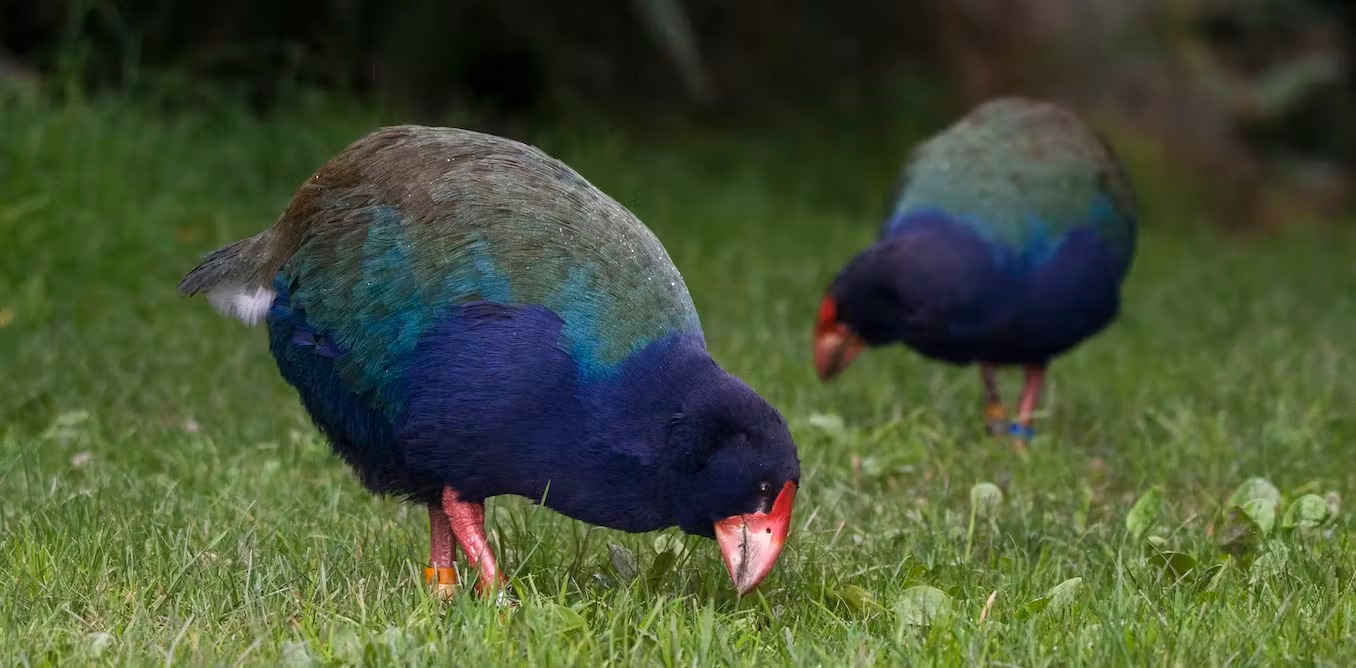Takahē are a striking bird and a national treasure in Aotearoa New Zealand. But the history and origin story of this flightless swamp hen have become a point of scientific debate.
Our latest research uncovered the significant impact of humans and past climate change on takahē. Genetic analysis has also revealed that takahē are closely related to their extinct North Island cousin, the moho, contrary to previous research and established ideas.
So what is the story behind this large, prehistoric bird, once believed to be extinct? And how might this new knowledge improve efforts to protect the unique species?
A debated origin story
The evolutionary history of takahē and moho has long puzzled scientists. Previous genetic analysis of small fragments of DNA suggested they were not close relatives. Instead, it was believed they descended from two separate arrivals to New Zealand by an ancient species of swamp hen.
This evolutionary history has become conventional wisdom. But it’s different to the origin story of the majority of New Zealand’s birds with related species in the North and South Islands (such as tīeke and kōkako). Most New Zealand birds descend from a single colonisation event, not two.
Our new research has upended the takahē origin story. Using palaeogenetic techniques we sequenced takahē and moho DNA from fossil, archaeological, historical and living individuals to reconstruct their evolutionary history.
Our findings suggest the Australian or Pacific swamp hen ancestor of takahē and moho arrived in New Zealand four million years ago, as the previously forested landscape began to open up with a cooling climate.
Around 1.5 million years ago, a land bridge between the North and South Islands allowed the now possibly flightless swamp hen to evolve into takahē in the south, and the taller and slighter moho in the north. This land bridge eventually eroded with the development of Cook Strait around 500,000 years ago.
Ice ages and human arrival
Our genetic analyses and the fossil records show takahē were restricted to isolated areas in the northwestern and perhaps southern South Island at the height of the last ice age – 29,000 to 19,000 years ago.
As the climate warmed, takahē shifted their distribution to eastern and southern regions. The takahē in the northwest South Island (where the Heaphy Track is today) went locally extinct.
However, the biggest impact on takahē came with the arrival of East Polynesian colonists in the late 13th century. Over-hunting, habitat destruction and predation from kiore (Polynesian rats) and kurī (Polynesian dogs) resulted in the loss of takahē everywhere except Fiordland.
This dramatic contraction and population bottleneck resulted in a small and inbred population with little to no genetic variation. There is no evidence of the genetic lineage (a series of mutations or changes in the genetic code which connect an ancestor to its descendants) of living takahē in any archaeological or fossil specimens we examined.
This lineage may have only occurred in Fiordland, or was extremely rare in takahē and swept to dominance in this small population.
Another possibility suggests this lineage occurred spontaneously – much like the genetic mutation in Queen Victoria that gave rise to haemophilia in members of Europe’s royal families.
We know from historical records that the arrival of Europeans and their furry companions no doubt resulted in further restriction of already rare takahē to the Murchison Mountains in Fiordland. However, we don’t see any further genetic bottleneck at this point, as the damage had already been done by earlier human activity.
The moho suffered the same fate as takahē, with the last probable sighting in the late 1800s. The demise of moho and the near extinction of takahē opened up a job vacancy in the ecosystem, allowing the pūkeko to colonise New Zealand from Australia around 500 years ago.
Improving conservation management
The growing field of conservation palaeontology uses the fossil record to inform conservation management decisions. It is especially important for endangered animals where human impact has masked their true biological heritage.
Kea, despite appearances, are not an alpine bird. Likewise, the ideal habitat of takahē is not tussock. Rather, the fossil record suggests takahē preferred border habitats such as the edges of forests, grasslands and shrublands, where one habitat transitions to another.
Conservation palaeontology can and should be used to determine the range of suitable habitats across the country, based on the preferences of prehistoric takahē. This can be married with effective predator control to support takahē populations.
It has long been known that takahē underwent a population bottleneck upon human arrival, but what surprised us was its scale. Our research highlights the need for conservation efforts to maximise the amount of genetic variation passed down to each generation, and to minimise the amount and consequent impacts of inbreeding.
Although threats to our native wildlife exist in the here and now, the past can be a key to future efforts to conserve our precious biodiversity.



 How America courted increasingly destructive wildfires − and what that means for protecting homes today
How America courted increasingly destructive wildfires − and what that means for protecting homes today  The UK is surprisingly short of water – but more reservoirs aren’t the answer
The UK is surprisingly short of water – but more reservoirs aren’t the answer  Rise of the Zombie Bugs takes readers on a jaw-dropping tour of the parasite world
Rise of the Zombie Bugs takes readers on a jaw-dropping tour of the parasite world  GesiaPlatform Launches Carbon-Neutral Lifestyle App ‘Net Zero Heroes’
GesiaPlatform Launches Carbon-Neutral Lifestyle App ‘Net Zero Heroes’  Parasites are ecological dark matter – and they need protecting
Parasites are ecological dark matter – and they need protecting  Fertile land for growing vegetables is at risk — but a scientific discovery could turn the tide
Fertile land for growing vegetables is at risk — but a scientific discovery could turn the tide  We combed through old botanical surveys to track how plants on Australia’s islands are changing
We combed through old botanical surveys to track how plants on Australia’s islands are changing  Extreme heat, flooding, wildfires – Colorado’s formerly incarcerated people on the hazards they faced behind bars
Extreme heat, flooding, wildfires – Colorado’s formerly incarcerated people on the hazards they faced behind bars  As the Black Summer megafires neared, people rallied to save wildlife and domestic animals. But it came at a real cost
As the Black Summer megafires neared, people rallied to save wildlife and domestic animals. But it came at a real cost  Swimming in the sweet spot: how marine animals save energy on long journeys
Swimming in the sweet spot: how marine animals save energy on long journeys  Drug pollution in water is making salmon take more risks – new research
Drug pollution in water is making salmon take more risks – new research  Burkina Faso and Mali’s fabulous flora: new plant life record released
Burkina Faso and Mali’s fabulous flora: new plant life record released 

































